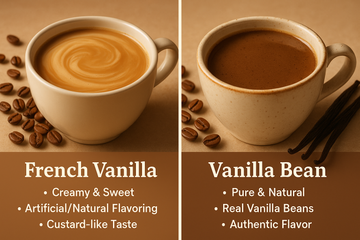Understanding the distinct characteristics between French vanilla and vanilla bean coffee can transform your brewing experience. These two popular vanilla-flavored options offer unique taste profiles, preparation methods, and aromatic qualities that appeal to different coffee preferences.
The world of vanilla-flavored coffee presents coffee enthusiasts with delightful options, but the choice between French vanilla and vanilla bean can be confusing. While both offer the beloved vanilla essence, they deliver distinctly different experiences in your cup. Understanding these differences will help you make informed decisions about which vanilla coffee suits your taste preferences and brewing style.
What is French Vanilla Coffee?
French vanilla coffee represents a flavoring approach rather than a specific vanilla variety. The term "French vanilla" originated from the French method of making vanilla ice cream using egg yolks, which created a richer, creamier base with a custard-like quality. In coffee applications, French vanilla flavoring aims to replicate this smooth, creamy, and slightly sweet profile.
French vanilla coffee typically uses artificial or natural vanilla flavoring combined with additional compounds that create a sweeter, more dessert-like taste. The flavoring often includes notes of caramel, butter, and cream, resulting in a more complex flavor profile that goes beyond pure vanilla. This makes French vanilla coffee appealing to those who prefer sweeter, more indulgent coffee experiences.
The production process for French vanilla coffee involves adding flavoring oils or syrups either during the roasting process or after brewing. Many commercial French vanilla coffees use a combination of natural and artificial flavors to achieve consistency and intensity in every cup.
Understanding Vanilla Bean Coffee
Vanilla bean coffee focuses on capturing the authentic essence of real vanilla beans, typically sourced from Madagascar, Tahiti, or Mexico. This approach emphasizes the pure, natural vanilla flavor without additional sweetening agents or cream-like additives. Vanilla bean coffee aims to showcase the complex, floral, and slightly woody notes inherent in quality vanilla beans.
The flavor profile of vanilla bean coffee tends to be more subtle and sophisticated compared to French vanilla. Real vanilla beans contain over 250 flavor compounds, creating a nuanced taste experience that includes floral, spicy, and sometimes fruity undertones. This complexity makes vanilla bean coffee particularly appealing to coffee purists who appreciate natural flavoring.
Premium vanilla bean coffee often uses whole vanilla bean extracts or ground vanilla bean specks, which can sometimes be visible in the coffee grounds or final brew. This visual element adds to the authentic experience and indicates the use of real vanilla components.
Flavor Profile Comparisons
The taste differences between French vanilla and vanilla bean coffee are significant and immediately noticeable. French vanilla coffee delivers a sweeter, creamier taste with pronounced dessert-like qualities. The flavor tends to be more forward and intense, often masking some of the coffee's natural characteristics. This makes it an excellent choice for those who prefer flavored coffee that tastes distinctly different from regular coffee.
Vanilla bean coffee offers a more refined and subtle vanilla experience. The natural vanilla complements rather than overwhelms the coffee's inherent flavors, creating a harmonious balance. The taste is typically less sweet and more complex, with the vanilla serving as an enhancement rather than the dominant flavor component.
In terms of sweetness levels, French vanilla coffee generally requires less additional sweetener due to its inherently sweet flavor profile. Vanilla bean coffee maintains a more neutral sweetness level, allowing drinkers to customize their preferred sweetness without competing with artificial flavoring.
Brewing Considerations and Techniques
The brewing approach can significantly impact how these vanilla flavors express themselves in your final cup. French vanilla coffee often performs well with standard brewing methods, as the robust flavoring can withstand various extraction processes. However, over-extraction can sometimes intensify artificial flavor notes, so monitoring brew time and temperature becomes important.
Vanilla bean coffee requires more careful attention to brewing parameters to preserve the delicate natural vanilla compounds. Lower brewing temperatures around 195-200°F help maintain the subtle flavor notes, while shorter extraction times prevent the vanilla from becoming bitter or overpowering.
For French vanilla coffee, brewing methods like drip coffee makers, single-serve machines, and even cold brew work effectively. The strong flavoring translates well across different brewing techniques, making it versatile for various preparation preferences.
Vanilla bean coffee often shines with pour-over methods, French press, or carefully controlled espresso extraction. These methods allow for precise control over brewing variables, helping to highlight the natural vanilla complexity without overwhelming the coffee base.
Quality and Ingredient Considerations
The quality differences between French vanilla and vanilla bean coffee often relate to the source and processing of flavoring agents. High-quality French vanilla coffee uses natural vanilla extracts combined with natural cream and butter flavoring compounds. Lower-quality versions may rely heavily on artificial vanillin and synthetic cream flavors.
Premium vanilla bean coffee typically features single-origin vanilla beans and clearly identifies the vanilla source region. Madagascar vanilla beans offer rich, creamy notes, while Tahitian vanilla provides more floral characteristics, and Mexican vanilla delivers spicier undertones.
When selecting either variety, examining ingredient lists helps identify quality levels. Look for terms like "natural vanilla extract," "vanilla bean," or specific vanilla origin mentions rather than generic "natural and artificial flavors."
Pairing and Serving Suggestions
French vanilla coffee pairs excellently with sweet breakfast items like pastries, muffins, or pancakes. Its dessert-like qualities also make it suitable as an afternoon treat or after-dinner coffee. The rich, creamy flavor complements foods with similar profiles, such as caramel desserts or cream-based treats.
Vanilla bean coffee offers more versatility in food pairings due to its subtle nature. It works well with both sweet and savory breakfast options, light pastries, or even as a complement to chocolate desserts where the vanilla can provide contrast rather than competition.
For milk-based drinks, French vanilla coffee creates indulgent lattes and cappuccinos with enhanced sweetness and creaminess. Vanilla bean coffee produces more balanced milk drinks where both the coffee and vanilla characteristics remain distinct and appreciable.
Making Your Choice
Choosing between French vanilla and vanilla bean coffee ultimately depends on your flavor preferences and intended use. French vanilla suits those who enjoy sweeter, more dessert-like coffee experiences and prefer bold flavoring that transforms their regular coffee routine. It works particularly well for special occasions or when you want coffee that feels like a treat.
Vanilla bean coffee appeals to coffee enthusiasts who appreciate subtle enhancement and natural flavoring complexity. It's ideal for daily drinking when you want vanilla notes without overwhelming sweetness or artificial taste elements.
Consider your typical coffee additions as well. If you regularly add cream and sugar, vanilla bean coffee might provide sufficient flavor enhancement without additional sweetness. If you prefer your coffee to taste distinctly flavored without additions, French vanilla might better meet your expectations.
Both varieties offer unique pleasures in the world of flavored coffee, and understanding their differences helps you select the perfect vanilla coffee experience for any moment or mood.






